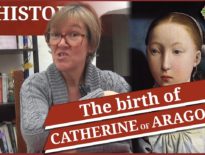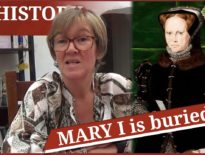On this day in Tudor history, 15th December 1558, Cardinal Reginald Pole, Mary I's Archbishop of Canterbury and her chief advisor, was buried at Canterbury Cathedral. Coincidentally, Cardinal Pole had died the same day as his queen, on 17th November 1558.
Find out a bit more about Cardinal Pole, his background, death and burial, in today's talk.
Also on this day in history:
- 1558 – Death of James Fleming, 4th Lord Fleming and Lord Chamberlain of Scotland, at Paris. He had been in France as a commissioner representing Scotland at the wedding of Mary, Queen of Scots, and Francis, the dauphin, and was taken ill with other commissioners after they had told the French that they had no authority to grant Francis the crown matrimonial. Fleming and three other commissioners died, and it was suspected that they had been poisoned.
- 1560 – Death of Thomas Parry, Comptroller of the Household to Elizabeth I and Lord Lieutenant of Berkshire. He was buried at Westminster Abbey.
- 1605 – Death of Sir Francis Gawdy, Judge and Chief Justice of the Common Pleas, of apoplexy at Sergeant's Inn. He had only been Chief Justice for four months. As Queen's Sergeant in 1586, Gawdy had opened the trial against Mary, Queen of Scots. He was buried at Rungton, near Wallington in Norfolk.
Transcript:
On this day in Tudor history, 15th December 1558, Cardinal Reginald Pole, Mary I’s Archbishop of Canterbury, was buried at Canterbury Cathedral.
Pole was fifty-eight years old at the time of his death, having been born in March 1500. He was the third son of Sir Richard Pole and his wife, Margaret, Countess of Salisbury. Pole’s maternal grandfather was George, Duke of Clarence, brother of Kings Edward IV and Richard III, and his maternal grandmother was Isabella Neville, daughter of Richard Neville, Earl of Warwick, the King maker.
Pole refused to support King Henry VIII in his quest for an annulment of his marriage to Catherine of Aragon, and even wrote a treatise against it. He was made a cardinal in 1536 and then papal legate in 1537. His strong and outspoken opposition to Henry VIII and his policies ultimately led to the execution of his brother, Lord Montagu, the imprisonment of his other brother, Geoffrey, and later the execution of his mother, the Countess of Salisbury. The cardinal himself was also attainted, but he was safely on the Continent.
Cardinal Pole returned to England in late 1554, following the accession of the Catholic queen, Mary I, and on 30th November 1554, Pole, as legate, officially welcome England back into the Catholic fold. He was consecrated as Archbishop of Canterbury in 1556 and was the queen’s chief adviser.
Cardinal Pole became ill in September 1558 and succumbed to his illness on 17th November 1558, the very same day as his beloved queen, Mary I.
Raphael Holinshed's Chronicles record his death:
“Leaving queen Marie being dead & gone, you are to understand and note, that the same evening, or (as some have written) the next day after the said queen’s death, Cardinal Pole the bishop of Rome’s legate departed out of this life, having been not long afore made archbishop of Canturbury: he died at his house over against Westminster commonly called Lambeth, and was buried in Christs church at Canturbury.”
The Chronicles go on to give a not so flattering account of Cardinal Pole's life, accusing him of “barbarous” behaviour and blemishing “the honour of his descent”.
Diarist and merchant tailor Henry Machyn records how Cardinal Pole's remains were taken on 10th December from Lambeth to Canterbury in preparation for his burial:
“The same morning my lord cardinal was removed from Lambeth, and carried toward Canterbury with great company in black; and he was carried in a chariot with banner-rolls wrought with fine gold and great banners of arms, and 4 banners of saints in oil.”
In Ecclesiastical Memorials, John Strype writes:
“Cardinal Pole died the same day that Queen Mary did; and not many hours after her. His last will may be seen in Holinshed's History. Therein he desired his successor would not sue his executors for dilapidations, seeing he had bestowed more than a thousand pounds within these few years in repairing and making such houses as belonged to the see, since he came to it. The overseers of his will were Nicholas Archbishop of York, lord chancellor; Thomas Bishop of Ely; Ed. Lord Hastings, lord chamberlain; Sir John Boxal, the Queen's secretary; Sir Edward Cordal, master of the rolls; Henry Cole, vicar general of the spiritualities.”
Strype goes on to describe how there was “a secret report among Papists, abroad soon after, that both Queen Mary and Cardinal Pole, came to their ends by poison but that Dr. Haddon, ‘a knowing man’, put their deaths down to “an infectious fever that the nation then laboured under [...] an outrageous burning fever [...]”, which would be referring to the influenza epidemic.
Cardinal Pole’s rather plain tomb can be found on the north side of the Corona (or Becket’s Crown) in Canterbury Cathedral. Pole was the last prelate to be buried in the cathedral.



Leave a Reply